Bridge to the future: Faculty receive Alumni Fellowship Awards
Deeply engaged in research, significant contributors to teaching and scholarship, and mentors to their students, William & Mary professors are the cornerstone of a university that produces extraordinary graduates.
Each year, the Alumni Association recognizes five exceptional faculty members with the Alumni Fellowship Award, endowed by the Class of 1968. Recipients receive a $1,000 honorarium and are celebrated at the Fall Awards Ceremony. Each professor recognized possesses outstanding qualities that have contributed to the College’s remarkable reputation.
Joining William & Mary’s faculty roster seven years ago, psychology professor Danielle Dallaire is working in her dream job in a department she is truly passionate about. After being turned on to psychology while in high school by her older brother, Dallaire never looked back and pursued psychology as her primary area of focus during her undergraduate and graduate years of study that began at Pennsylvania State University.
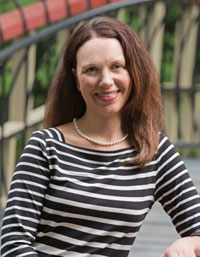 Most of Dallaire’s current research is focused on at-risk youths, and she just wrapped up a study on the emotional competency of children with incarcerated mothers in which more than 150 children, caregivers and mothers were subjects. Dallaire continues to work with the College’s Healthy Beginnings Project that seeks to identify pregnancies in women who are incarcerated and provide them constant care and support throughout their pregnancies.
Most of Dallaire’s current research is focused on at-risk youths, and she just wrapped up a study on the emotional competency of children with incarcerated mothers in which more than 150 children, caregivers and mothers were subjects. Dallaire continues to work with the College’s Healthy Beginnings Project that seeks to identify pregnancies in women who are incarcerated and provide them constant care and support throughout their pregnancies.
Dallaire expects this service initiative to be long-term as it is a great help to the community, especially the women and children it is designed to assist. Dallaire is looking forward to getting back in the classroom this fall after focusing on research during the past academic year, and she is particularly excited about sharing her love for community service in her upcoming courses. “Some of the service learning courses we have been working on in the psychology department, as well as in the community studies minor and the public health minor, are really going to take off over the next couple of years. To help students see how psychology can be applied in community settings is definitely a goal of mine.”
William & Mary provides the perfect environment for Dallaire to share her passion for learning and service, thanks in large part to the community of faculty and students who are eager to be a part of her mission. “There are so many great things about working at William & Mary.
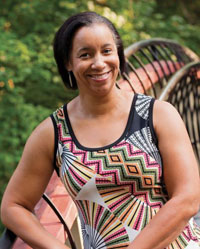
Glenn notes the high levels of enthusiasm and motivation that characterize William & Mary students, and she enjoys sharing her “passion and knowledge of dance while cultivating greater interest in the art form with students of varying levels of experience and ability.”
Glenn’s wealth of experience is certainly extensive, as she has been working and studying in the industry for over a decade. Prior to her work at the College, Glenn served as the artistic director of Cecil Dance Theatre for 10 years, and during her time there she choreographed original modern dance works as well as reconstructing popular ballets such as The Nutcracker, The Sleeping Beauty and Coppelia. Glenn was head of dance at Hampton University for two years, where she established the first African-American chapter of the National Dance Association’s Nu Delta Alpha Honor Society. In addition to her original work and reconstructions, she also co-choreographed Journey of Destiny, the retelling of the settlement of Jamestown that was featured in Jamestown’s 400th anniversary celebration. Her choreography has been presented by the College of William & Mary, Hampton University, the Maryland School of Ballet and Modern Dance and Colonial Williamsburg. Three of her most recent works, Transcending Rhythms, Changing the Change and Before I Go, While I’m Away, When I’m Gone were presented at the 2009, 2010 and 2011 International Association for Blacks in Dance conferences. She is currently a member of Gravity Optional Dance Company.
Glenn is “excited and honored” by her recognition as an Alumni Fellowship Award winner and will continue to mentor students with a passion for dance in her upcoming ballet, modern dance and historical dance classes.
Even when he was younger, Eric Hilton loved to figure out how animals were put together. When he had to miss school, he would go to work with his mom, a professor of human anatomy, and watch her prepare cadavers for her lab.
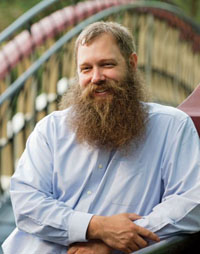 Hilton was doing a postdoc in Chicago when he heard about a new position at William & Mary. “I saw the advertisement for the position of a comparative anatomist. Not a lot of positions have that emphasis. I would get to teach about fishes from the morphological perspective. You don’t know how long I waited for someone to say that!”
Hilton was doing a postdoc in Chicago when he heard about a new position at William & Mary. “I saw the advertisement for the position of a comparative anatomist. Not a lot of positions have that emphasis. I would get to teach about fishes from the morphological perspective. You don’t know how long I waited for someone to say that!”
Comparative anatomy is the study of similarities and differences in the anatomy of species, long serving as evidence of evolution and helping scientists classify organisms. It’s a field that was recognized back in the 1500s, but Hilton wants people to realize that it is not a dead discipline. “We’re coming at it with a new approach, new sets of eyes, a new ability to see the world. Every time we think the field is becoming mature, advances continue to be made and it becomes new again.”
Hilton joined the Virginia Institute of Marine Science (VIMS) in 2007, focusing on the anatomy of fishes. In addition to teaching classes, he is also the curator of the Ichthyology Collection at VIMS, one of the largest repositories for freshwater, Chesapeake Bay and coastal fishes in Virginia. “The job reflects the diverse interests that I have. Classical anatomy, genetics, morphological ecology, working with larval fishes; it’s all threaded together with evolution and fish biology and what it can tell us about conservation.”
Hilton is an internationally recognized expert in sturgeon anatomy and classifications, using dissection and detailed studies of a sturgeon’s skeleton, muscles and morphology to place a specimen in the correct species. Of the 25 currently recognized species of sturgeons worldwide, every one is endangered, threatened or afforded some type of legal protection. Classification of sturgeons is important so authorities can make informed conservation decisions.
“It’s important to understand the natural world in all facets,” said Hilton. “I hope my research contributes to understanding the interconnectivity of species. You can learn a lot from a dead fish.”
Erin Minear
Assistant Professor of English
Drawn to William & Mary because of its unique qualities as a “public ivy,” English professor Erin Minear has greatly enjoyed her experience at the College since joining the faculty in 2010. The College’s resident Shakespeare expert, Minear relishes the opportunity to teach Shakespeare in many different forms, whether it be a broad study of the bard’s works or a closer study of his greatest literary feats. “It’s been particularly rewarding to teach a seminar that focuses on Shakespeare’s Othello — the play itself and the way audiences and critics have responded to it over the centuries. You might think that it would be hard to spend an entire semester on just one play, but the opposite is true!”
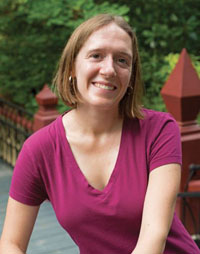 Although the focus of her teaching and research is centered around Shakespeare and other Renaissance-era authors, Minear likes to keep things interesting and branch out to teach some unique classes in the English department. “For something completely different, I’ve also greatly enjoyed teaching a class on children’s fantasy literature. We read C.S. Lewis, J.K. Rowling … that was a lot of fun.”
Although the focus of her teaching and research is centered around Shakespeare and other Renaissance-era authors, Minear likes to keep things interesting and branch out to teach some unique classes in the English department. “For something completely different, I’ve also greatly enjoyed teaching a class on children’s fantasy literature. We read C.S. Lewis, J.K. Rowling … that was a lot of fun.”
In the coming years at the College, Minear will teach more Shakespeare, of course, but she is planning some future classes around some of his lesser-known works. “All of these plays are fascinating, and they have a lot to show us about Shakespeare’s development and the topics that were important to him.”
Minear delights in her research as well as her time in the classroom, and she particularly appreciates how the two “reinforce and nourish each other” to create the ultimate learning experience. She continues to be thoroughly impressed by the entire William & Mary community and says the people of the College are “everything you would want them to be. The students here are fabulous — they’re very smart and excited about learning, very energetic and hardworking.”
Minear was exceptionally pleased to be recognized for her teaching abilities this year. “I’m so honored to have received this award. It was the example of my own professors, as an undergraduate, that made me want to do this job in the first place, so my teaching is very important to me.”
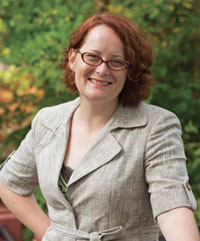
Vahle’s research focuses on neutrinos, one of the fundamental constituents of matter. “As far as we know, you can’t break it open and find smaller particles inside. It’s kind of an oddball in the family of particles, though. It has no electrical charge and it doesn’t feel the strong force that holds the nuclei of atoms together. It only interacts via the very weak force that is responsible for radioactive decays of certain nuclei. Since that force is so weak, matter is largely transparent to neutrinos. A neutrino can zip right through most materials and come out the other side, leaving no trace of its passage.”
When neutrinos were first discovered, they were thought to have no mass. Just recently, scientists discovered they do have mass, but it’s really small. The fact that the next heaviest fundamental particle is the electron, which is at least 10 million times heavier, raises an interesting question. “Why is there such a large difference in the mass scales of the fundamental particles?” said Vahle. “If we hope to understand the origin, structure and evolution of the universe, we need to know all secrets the neutrinos are keeping.”
Vahle has been teaching at the College since 2007. “I’m always learning something new,” said Vahle. “It doesn’t matter how many times I’ve taught a class, I keep finding new insights. The same is true of research. Each problem forces you to learn new tools or technology. Once you solve all the problems and run the experiment, sometimes you end up with a deeper understanding of how nature works.”
Vahle is part of a group of researchers doing experiments hosted by Fermi National Accelerator Laboratory in Illinois. Scientists collaborate to build detectors, run the detectors, collect data and then analyze it. “The collaborations develop a hierarchical organizational structure to coordinate everyone’s efforts and make sure the experiment runs smoothly. I was the analysis coordinator for MINOS, which is one of the experiments I work on,” said Vahle. “It’s a position of leadership, overseeing the progress on all the different analyses that are going on. Having started out as a young graduate student on the experiment, it felt like an achievement to work my way up the ranks.”
Editor's note: This story originally appeared in the fall 2013 issue of the William & Mary Alumni Magazine.
















